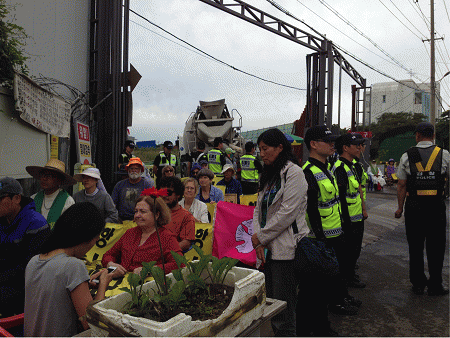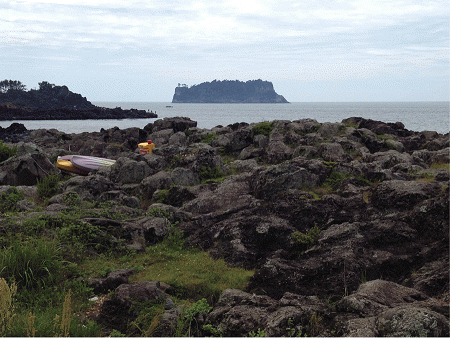Reprinted from War Is A Crime
South Korea constructs new Naval Base on Jeju Island, U.S. Plans to Expand Military Base on Okinawa and China Builds on South China Sea Atolls
The international community is extraordinarily concerned about the Chinese construction on small islands and atolls in disputed waters off China, Vietnam, Taiwan and Japan. Over the past 18 months, the Chinese government has created islands out of atolls and larger islands out of small ones.
With the Obama administration's "pivot" of the United States military and economic strategy to Asia and the Pacific, the Chinese have seen military construction in their front yard.
I've just returned from my third trip to Jeju Island, South Korea. Jeju is called the Island of Peace. However, it's where the South Korean military has almost finished construction of a new naval base, the first military base on this strategically located island south of the mainland of Korea that is littered with U.S. and South Korean military bases, left over from the Korean war and that are a part of the U.S. "defense" of South Korea from "aggression" from North Korea.
The Jeju Island naval base will be the homeport for ships that carry the U.S. Aegis missiles. Many on the island call it a U.S. naval base since it will be a key part of the U.S. "pivot" to Asia and the worldwide U.S. missile defense system. They believe that the naval base will be used as frequently by U.S. warships as by South Korean ships and submarines. With a naval base on Jeju Island, they believe that Jeju Island becomes a target should military hostilities break out in Asia and the Pacific.
The naval base was built in the pristine waters off Gangjeong Village midst seven years of intense civic outrage. The destruction of the marine environment off the village where the famous women divers for decades have harvested by hand the "fruits of the sea" is one of the cultural and economic losses the construction of the naval base has caused.
The destruction by huge dynamite explosions of a unique geologic rock formation called "Gureombi" is a cultural and spiritual loss to the islanders. Its tide pools, crystal clear springs and lava rock formations made "Guremobi" a favorite area for villagers and visitors to the island.
The construction of the naval base in spite of strong local opposition is a part of the history of oppression of the people of Jeju Island from the mainland government. After the Korean War, South Korean and United States military forces which conducted the infamous April 3 massacres of over 30,000 islanders who were believed to be opposed to the right wing Singman Rhee government, dissidents and sympathizers for reunification of Korea. The April 3 "incident" left a deep scar on the people of Jeju Island and made them very sensitive to mainland government policies, particularly those which "target" them again.
The South Korean government has built the naval base in one of the most inhospitable areas of Jeju Island. The naval base faces the open ocean and has already been battered by two typhoons which have displaced huge concrete cassions which form the foundation of the quarter-mile breakwater created to protect the base from the sea. The government attempted to put the base at two more favorable geographic locations on Jeju Island but were deterred by citizens who successfully refused to allow the base to be constructed in their part of the island.
Despite large and continuing protests in Gangjeong village against the construction of the naval base, the South Korean national government reportedly with intense pressure from the United States decided that they had to begin construction somewhere on the island and chose to ignore the strong local opposition.
However, the decision has come at a great cost to the national government. Daily demonstrations and frequent large demonstrations with planeloads of mainlanders flying into help islanders, have resulted in the government having to deploy hundreds of police from the mainland to counter the demonstrations. Local police on Jeju Island are felt to have too much sympathy for the demonstrations and therefore police from the mainland are needed. Islanders see this as an historic throwback to the April 3, 1948 oppression of opposition to mainland government policies.
Each day at Gangjeong village begins with a 7am demonstration of 100 "bows" at the front gate of the naval base. Protesters block one lane of the base forcing a slowdown of traffic of concrete trucks and other vehicles entering the base. For almost an hour, the demonstrators silently offer thoughts on the militarization of their island as they bow or kneel. At 11am Catholic priests and laywomen conduct a daily mass across from the front gate as other priests and activists sit in chairs blocking both lanes into and out of the base. Every 20 minutes, a platoon of young police men and women march into the seated protesters and carry the chair and the person sitting in it to the side of the road, opening the road for traffic for five minutes. Then the police march back into the base and the protesters immediately move their chairs back to block the lanes into the base. After an hour of blocking the entrance, the protest ends with an energetic dance -- and traffic resumes. Long-time activists recognize that the hour protest is a small delay in the construction of the base, but consider the two daily protests as extremely important actions to remind the national government of their continuing opposition to the military base.

Nobel Peace laureate Mairead Maguire, Ann Wright, Catholic sisters and other Gangjeong activists after having been lifted up and carried in chairs out of the road to allow steady stream of concrete trucks to enter the naval base.
(Image by Ann Wright) Details DMCA
My first visit to Jeju Island was in 2011. At that time, activists still had their camp on the Guremobi rocks on the edge of the ocean. The camp consisted of a long educational tent, a sleeping tent and a cook and eating tent. Every day activists would conduct workshops and ceremonies on the rocks.
(Note: You can view every article as one long page if you sign up as an Advocate Member, or higher).






